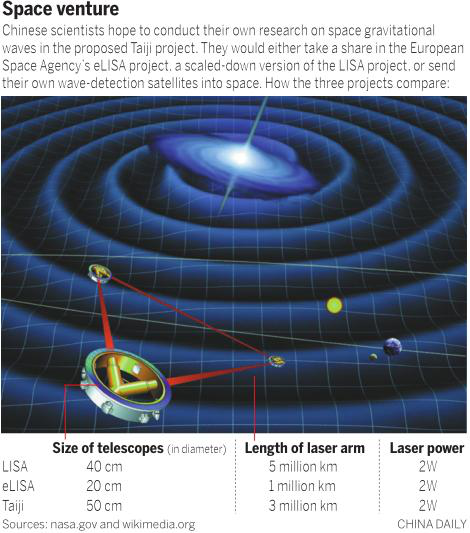By Tom McGregor, CCTV.com Panview commentator and editor
Chinese scientists are blazing new trails in the science & technology fields. From patenting groundbreaking inventions to setting up more powerful telescopes, the Chinese Academy of Sciences (CAS) has earned worldwide recognition for supporting scientific projects that are transforming the world as we know it.

(Picture from China Daily)
In recent years, CAS has encouraged Chinese scientists to make further discoveries in astronomy that has led to more in-depth research on quantum theory, black holes, pulsars and gravitational waves.
On January 2017, CAS announced they would start to set up the world’s highest altitude gravitational wave telescopes - Ngari No. 1 and Ngari No. 2 - in the Tibet Autonomous Region that can detect the faintest echoes from the universe resonating from our universe, according to Xinhua.
Collaboration but in isolation
The telescopes’ location is 30-km. south of Shiquanhe Town, Ngari Prefecture. The first phase telescope will be 5,250-meters above sea-level and scheduled for operations in 2021.
The Ngari No. 1 can detect and gather precise data on primordial gravitational waves in the Northern Hemisphere. Afterwards, the Ngari-2 will be set up nearby, but at 6,000-meters above sea-level.
Both telescopes will be installed at the Ngari Gravitational Wave Observatory with total construction costs estimated at RMB130 million (US$18.8 million).
Yao Yongqiang, chief researcher of National Astronomical Observatories of CAS, will lead the project. The Ngari Prefecture is home to high mountains and few people, making it easier for scientists to detect the slightest movements in the cosmic light.
The Ngari Observatory would stand alongside the South Pole Telescope and a facility in Chile’s Alacama Desert as crucial sites for China’s gravitational waves’ research.
Why important?
Gravitational waves are “ripples” in a space-time continuum that are caused by violent and energetic processes in the universe. Albert Einstein had predicted its existence in 1916 when he published a book on the general theory of relativity.
Scientists believe massive accelerating objects, including neutron stars or black holes, that are orbiting each other can disrupt space-time through “waves” of distorted space that would radiate from a source.
Xinhua likens it to the ripples you see from a stone that is thrown in a pond. The ripples travel at the speed of light through the universe, while carrying information about their origins and provide valuable clues on the nature of gravity.
Additionally, some scientists think that by conducting research on gravitational waves, they can gain a better understanding on the Big Bang, which is a scientific theory explaining how our universe came into being.
Going deeper
On February 11, 2016, scientists based in the United States, working at the Laser Interferometer Gravitational-Wave Observatory (LIGO) announced they were the first to observe gravitational waves, which were generated from a black hole merger. The same team made a second detection on June 15.
Nonetheless, Xiong Shaolin, scientist at the Institute of High Energy Physics for CAS, was not amazed. He told Xinhua the position accuracy of all gravitational wave events that were detected so far are “poor.”
“If scientists can find electromagnetic signals happening at similar positions and times of the gravitational wave events, it will increase the reliability of the detection,” said Xiong.
He added, “Combined analysis of the gravitational waves and electromagnetic signals will help reveal more about the celestial bodies emitting the gravitational waves.”
Xiong suspects what the American scientists detected was gamma-rays, not gravitational waves.
Gamma-rays blast
A roaring debate has ensued in scientific community circles over the proper identification gravitational waves and gamma-ray bursts.
Zhang Shuangnan, lead scientist for China’s Hard X-ray Modulation Telescope (HXMT) and director of the Key Laboratory of Particle Astrophysics for CAS, wants more monitoring of gamma-ray bursts, which is defined as intense radiation that emanates from a supernova, star collapsing or black hole.
“Since gravitational waves were detected, the study of gamma-ray bursts has become more important,”Zhang said. “In astrophysics research, it’s insufficient to study just the graitational wave signals.”
He added, “We need to use the corresponding electromagnetic signals, which are more familiar to astronomers to facilitate the research on gravitational waves.”
Zhang contends the HXMT can play a vital role to detect gamma-ray bursts and distinguish them from gravitational waves, since the HXMT when functional in 2020 can detect gamma-rays with high-sensitivity in energy, ranging from 200keV to several MeV.
Looking at the big picture
Chinese scientists, who are on a mission to conduct research on gravitational waves and gamma-rays, recognize the value of their endeavors.
“Gravitational waves provide us with a new tool to understand the universe, so China has to actively participate in the research,” Hu Wenrui, physicist and CAS member, told China Daily. “If we launch our own satellites, we will have a chance to be a world leader in gravitational wave research in the future.”
Hu addressed the topic last year - 2016 and in June 2017, China’s Long March 4B rocket launched the HXMT, known as Insight, into orbit 350 miles above the Earth.
Chinese scientists see space as the new frontier and are prepared to tackle new discoveries on gravitational waves and gamma-ray bursts.
Tmcgregorchina@yahoo.com
(The opinions expressed here do not necessarily reflect the opinions of Panview or CCTV.com)

Panview offers a new window of understanding the world as well as China through the views, opinions, and analysis of experts. We also welcome outside submissions, so feel free to send in your own editorials to "globalopinion@vip.cntv.cn" for consideration.
















